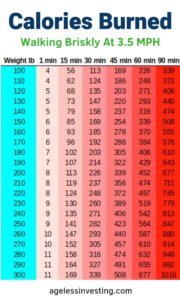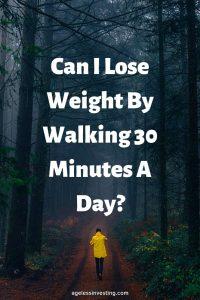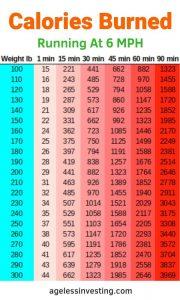Is walking to lose weight just burning calories?
Burning calories isn’t even the most important benefit of walking.
My college had a long outdoor stairwell known as “the steps.” I climbed “the steps” daily between classes to clear my mind and stay active. This experience inspired me to learn all the benefits of walking.
In this article, you will learn how walking is one of the healthiest things you can do.
Weight loss is just one of the many walking benefits. Losing or maintaining a healthy weight is the motivation to start walking.
Keep reading. Some of the benefits will surprise you.
Walking to Lose Weight Chart Lbs: Calories Per Minute

30 Walking Benefits
- Improves Circulation
- Promotes Weight loss
- Lowers blood pressure and cholesterol
- Lowers fasting blood sugar
- Reduces stress
- Increases lifespan/longevity
- Strengthens bones
- Boosts your mood
- Strengthens muscles
- Improves sleep
- Supports your joints
- Deepens your breathing
- Enhances Memory and cognitive function
- Slows mental decline
- It helps prevent Alzheimer’s disease
- It keeps you physically active
- Improves balance and coordination
- Inspires creativity
- Relieves allergies
- Saves money
- Lengthens telomeres
- It helps With pain relief
- Improves eyesight
- Increases social time
- Improves digestion
- Motivates you to make more healthy choices
- Boosts immune function
- Reduces food cravings
- Prevents disease, varicose veins
- It gives you fresh air

Walking Benefits For Weight Loss
Walking improves your metabolism and your exercise capacity in several ways.
Walking burns calories, builds muscles, strengthens bones, improves circulation, lowers blood sugar, and boosts mood.
1. Walking Improves Your Circulation
Walking increases your circulation by forcing your body to meet its needs. Circulation is the blood flow in your body.
Your blood delivers oxygen and nutrients throughout your body and removes wastes. Poor circulation means your arteries, the blood vessels that carry blood from your heart to your muscles and organs, are blocked or narrowed.
Generally, your extremities are the first to suffer from poor circulation as they are the farthest from your heart. Peripheral artery disease (PAD) is when your extremities, arms, and legs don’t get enough blood (1). The lack of oxygen to your muscles causes pain, fatigue, weakness, or numbness, especially in your hands and feet.
Why Is It Painful to Exercise WIth Poor Circulation?
When you exercise, your muscles need more oxygen. If you have healthy circulation, blood flow increases to your muscles. If you have poor circulation, your arteries can’t expand to increase blood flow to your muscles.
Walking a long distance with poor circulation can cause pain in your leg muscles, known as claudication (1). This pain should go away after resting. However, your body becomes more efficient every time you walk or exercise.
One sign of poor circulation is high blood pressure. Blood pressure is the force of blood pressing against the walls of your arteries (2). High blood pressure, or hypertension, is when your blood pressure is too high, forcing your heart to work harder to pump blood.
Chronic high blood pressure can damage your arteries and increase your risk of heart disease, stroke, and kidney disease (2).
Exercise causes high blood pressure, but only for the duration of your workout. Regular exercise forces your body to adapt by making blood flow more efficient and arteries more flexible. This means that exercise lowers your resting blood pressure.
Walking is a form of aerobic exercise or exercise that requires oxygen. Aerobic exercise helps with the following:
- Enlarges your heart muscles to improve pumping efficiency
- Improves circulation efficiency
- Reduces blood pressure
- Increases the number of red blood cells that help transport oxygen (3).
Action Plan:
Walk until it’s uncomfortable, then rest. When your pain goes away, start walking again. Gradually walk further or longer, and your circulation should improve.
2. Walking Burns Calories
Exercise plays an essential role in body weight regulation (4).
Walking helps you lose or maintain a healthy weight by burning calories, preserving lean muscle, and reducing belly fat.
A calorie is the heat needed to raise the temperature of one gram of water by one °C (5). A calorie is a measure of the energy in the food that you eat. You need calories, along with other nutrients, to fuel your body. However, your body stores excess calories as fat (6).
Fortunately, physical activity can help you burn excess calories (7, 8). One of the easiest ways to burn calories is to walk daily, especially after meals. Walking helps you lose weight and decreases your risk factor for severe health problems (9).
How many calories does walking burn?
Depending on gender and weight, walking one mile (1.6 km) burns about 100 calories (10). But how does walking compare to running for calorie burning?
One study found that running burned about 23 more calories per mile (8).
Walking and running burn calories, but walking is something you can do every day and for far longer. Also, it’s easier on your joints.
3. Walking Burns the Worst Kind of Fat
Walking helps you lose weight by burning abdominal fat or visceral fat.
Visceral fat surrounds your vital organs, such as your liver, pancreas, and intestines, and can increase your risk of type 2 diabetes and heart disease (12, 13).
Aerobic exercise, as simple as daily walking, is one of the most effective ways to lose unhealthy visceral fat (14, 15).
In one study, 20 obese women who walked three times a week for 50 to 70 minutes dropped their waist circumference by 1.1 inches (2.8 cm) and cut 1.5% of their body fat (16).
4. Walking Builds Muscle
Walking helps build and preserve muscle, which in turn helps maintain your metabolic rate. There are three main ways to build muscles.
- Walking tones your leg and abdominal muscles and even your arm muscles if you move them in your walk.
- It improves circulation, allowing your muscles to receive oxygen and nutrients to heal and rebuild faster. It also allows your body to remove waste more efficiently.
- It shifts pressure and weight from your joints to your muscles, thereby preserving your bones and joints and reducing pain. You can train or work harder or longer with less stress on your joints.
Lastly, walking can help you prevent age-related muscle loss, helping you stay young and active (17).
Walking Preserves Muscles
One problem with cutting calories is that you could lose muscle and body fat.
Unfortunately, people who lose weight also lose the metabolic activity of their body fat.
Muscle is more metabolically active than fat, helping you burn calories throughout the day. But exercises that preserve muscle, such as walking, can help maintain or improve your metabolic rate and keep off the extra weight (18, 19, 20, 21).
5. Walking Lowers Fasting Blood Sugar
Walking and running, especially after meals, can help lower blood sugar levels and help prevent diabetes.
The National Diabetes Education Program, run by the National Institute of Health, estimates that 79 million Americans are pre-diabetic. Pre-diabetes means your fasting blood sugar is higher than average, and you are at a greater risk of diabetes.
Diabetes is a disease in which blood sugar (glucose) is too high (22). Blood sugar comes from your food and is your body’s primary energy source.
Insulin, a hormone produced by the pancreas, unlocks cells to receive blood sugar for energy use. High fasting blood sugar generally means that the body doesn’t produce enough insulin or that you have insulin resistance.
Insulin resistance means that your cells have become less responsive to insulin.
Even though your blood sugar levels remain high, your cells are starving for energy. Further, remaining blood sugar can cause serious health problems such as heart disease and stroke (23).
Walking Can Help Prevent Diabetes
The National Walkers’ Health Study tested 33,060 runners and 15,945 walkers. Runners and walkers reduced their risk of diabetes by about 12% (24).
Interestingly, this study found that runners and walkers overestimate how long they exercise and sustain their activity. Because most studies estimate exercise dose by time and intensity, the researchers argue that the actual health benefits of exercise are underestimated.
When Is The Best Time To Walk For Weight Loss?
When you eat, you receive an influx of blood sugar. And any blood sugar that your insulin can’t escort into your cells remains in your bloodstream. Walking after meals helps burn your post-meal excess blood sugar.
One study of seniors found three 15-minute walks after each meal were as effective at lowering blood sugar levels over 24 hours as one 45-minute walk at the same pace (25).
The last meal of the day tends to be the largest. If you don’t burn off excess energy before bed, your blood sugar levels remain high until morning when you eat and raise them again. Therefore, after dinner is the best time to walk.
How Does Lowering Your Blood Sugar Help You Lose Weight?
Lowering your fasting blood sugar levels can help you lose weight in two ways.
- High fasting blood sugar levels can damage your arteries over time and slow your circulation.
- Lack of insulin or insulin resistance means that your cells lack blood sugar for energy. Instead of giving you energy, your body stores your remaining blood sugar in your muscles as glycogen or as a lipid in your fat tissue (26).
6. Walking Boosts Your Mood
Regular exercise, such as walking, can improve your mood. Further, you will likely continue if you enjoy an activity and recognize its benefits.
For example, studies have found that exercise reduces anxiety and depression (27). Exercise has positive effects on mood in both healthy and unhealthy people. But walking has an even more significant impact on those with anxiety and depression, as they have the most potential for change.
The best exercises for improving your mood are aerobic exercises that use large muscle groups, such as jogging, swimming, cycling, or walking, at moderate or low intensity (27). Further, exercise can reduce depression and anxiety in just one session.
Another study found that aerobic exercise, such as walking, promotes psychological improvements in stress, depression, mood, and anxiety (28).
Why Does Exercise Make You Feel Good?
Exercise releases endorphins. Endorphins have an analgesic effect, lowering your perception of pain and promoting positive feelings like morphine or a “runner’s high” (29).
Exercise also improves mood through the following:
- Increases body temperature
- It improves blood circulation in your brain
- Impacts your hypothalamic-pituitary-adrenal axis and physiological reactivity to stress (27)
- It gives your mind a distraction from your stresses and relieves cognitive dissonance.
Improving your mood makes it easier to continue positive changes until they become a habit. And you crave a good mood.
Studies have found that if you enjoy an exercise, you are likelier to continue it (30, 31, 32) Unless it’s too physically demanding (31).
That is why walking is the perfect mood booster. It’s not too strenuous and easy to enjoy with a friend.
7. Walking Helps You Keep Off the Weight
Only about 20% of overweight individuals who lose at least 10% of their body weight keep it off (33). Fortunately, individuals who lose weight for two to five years have a greater chance of long-term success.
Regular exercise, such as walking, is one of the best predictors of long-term weight loss success (34). Exercise increases your energy expenditure and helps set your energy balance for weight loss and maintenance.
Exercises such as walking for thirty minutes a day can help you maintain your weight loss, but exercising longer significantly impacts your weight loss (34).
Because walking preserves lean muscle, which is more metabolically active than fat, you burn more calories while exercising or resting.
Lastly, because regular exercise, such as walking, improves your mood, you are more likely to stay active and be social.

Can I Lose Weight By Walking 30 Minutes A Day?
Walking 30 minutes daily helps you maintain a healthy weight after losing weight. But if you want to lose weight, you should walk about 1 hour daily.
A recent study found that you must walk at least 150 minutes a week, or 75 minutes of jogging, to maintain your current weight (35). Also, those who have lost or are trying to lose weight should walk 200 to 300 minutes weekly (35, 36).
Another study found that those who exercised longer were more successful at maintaining their weight loss than those who exercised for a shorter time (37). The good news is that walking is more comfortable to maintain for longer and can be done daily.
How Long or Far Should You Walk Every Day?
Most studies and experts recommend walking at least 150 minutes (about 2.5 hours) weekly. However, if you walk even longer, you get even more health benefits. Remember that the benefits of exercise are underestimated.
One hundred fifty minutes a week is about 21 minutes a day or about one mile (1.6km) per day or seven miles (11.26km) per week. So, aim to walk at least a mile per day on average. You can walk faster to reach a mile sooner or walk slower and enjoy the walk.
How Long Do You Need To Walk To Start Burning Fat?
For about the first half-hour of exercise, your body burns sugars stored as fuel. After these stores are used, your body burns fat from your fat cells for fuel. So, one long walk is better for burning fat than several short walks that add up to the same amount of time.

Calories Burned Running Chart
Running, or walking quickly, burns more calories per hour, but it burns the same per mile. So, the quicker you walk, the sooner you burn off stored energy and start burning fat.
If you have the time, a long walk will burn as much fat as a short, faster walk or jog. You are active when walking, even at a slow pace, and being active is always better than sitting.
Walking is the best exercise because almost everyone can benefit from it.
Walking Action Plan
Plan a short walk after each meal to burn off extra calories and prevent your blood sugar from spiking. Also, plan one long walk daily for at least 30 minutes briskly. If you don’t have time for a long walk, plan a few five to ten-minute walks throughout the day,
- Take longer walks on days you have the time to make up for your busy days.
- Extend your walking time every week until you walk at least 150 minutes a week.
- If you’re trying to lose or maintain a healthy weight, you should walk between 200 and 300 minutes weekly.
- If you’re short on time, walk faster uphill or upstairs.
- Varying your pace and intensity helps lower your resting heart rate and raise your heart rate variability (HRV).
Further Reading:
What is A Good Resting Heart Rate For My Age?
You’ve Walked This Far…
This morning, you knew walking was good for you.
You know that walking can help you lose weight, but now you know how it can improve all areas of your life.
Now that you know the benefits of walking daily, will you take advantage of this gift?
What are your favorite walking benefits?
Sources Cited
- https://familydoctor.org/condition/peripheral-arterial-disease-and-claudication/
- https://www.webmd.com/hypertension-high-blood-pressure/ss/slideshow-hypertension-overview
- https://www.mydr.com.au/sports-fitness/aerobic-exercise-the-health-benefits
- https://www.ncbi.nlm.nih.gov/pmc/articles/PMC2931400/
- https://www.verywellfit.com/what-is-a-calorie-and-why-should-i-care-3496238
- https://www.ncbi.nlm.nih.gov/pubmed/28214525
- https://www.ncbi.nlm.nih.gov/pubmed/9181668/
- https://www.ncbi.nlm.nih.gov/pubmed/22446673
- https://www.ncbi.nlm.nih.gov/pubmed/18562968
- https://www.ncbi.nlm.nih.gov/pubmed/20613650
- https://sites.google.com/site/compendiumofphysicalactivities/Activity-Categories/walking
- https://www.medicalnewstoday.com/articles/320929.php
- https://www.ncbi.nlm.nih.gov/pubmed/18220642
- https://www.ncbi.nlm.nih.gov/pubmed/21951360
- https://www.ncbi.nlm.nih.gov/pubmed/17637702
- https://www.ncbi.nlm.nih.gov/pubmed/25566464
- https://www.ncbi.nlm.nih.gov/pubmed/20591106
- https://www.ncbi.nlm.nih.gov/pubmed/28507015
- https://www.ncbi.nlm.nih.gov/pubmed/7713045/
- https://www.ncbi.nlm.nih.gov/pubmed/19276190
- https://www.ncbi.nlm.nih.gov/pubmed/24457527
- https://www.niddk.nih.gov/health-information/diabetes/overview/what-is-diabetes
- https://www.niddk.nih.gov/health-information/diabetes/overview/preventing-problems
- https://www.ahajournals.org/doi/full/10.1161/atvbaha.112.300878
- http://care.diabetesjournals.org/content/early/2013/06/03/dc13-0084
- http://sugarscience.ucsf.edu/sugar-metabolism.html#.XA8NZWhKi00
- https://www.ncbi.nlm.nih.gov/pubmed/15518309/
- https://www.ncbi.nlm.nih.gov/pubmed/9973590
- https://www.webmd.com/depression/guide/exercise-depression#1
- https://www.ncbi.nlm.nih.gov/pubmed/16901889/
- https://www.ncbi.nlm.nih.gov/pubmed/25921307
- https://www.ncbi.nlm.nih.gov/pmc/articles/PMC4333108/
- https://www.ncbi.nlm.nih.gov/pubmed/16002825
- https://www.ncbi.nlm.nih.gov/pubmed/15561636
- https://www.ncbi.nlm.nih.gov/pubmed/26574810
- https://www.ncbi.nlm.nih.gov/pubmed/19127177
- https://www.ncbi.nlm.nih.gov/pubmed/10546695



An impressive content enumerating the different benefits we can get from walking. When my office was just a few meters away from my home, I walk everyday ti and from the office. I should say, that was very helpful. However, nowadays, my office is 60 kilometers away from home and need to use public transport everyday. I also lost the opportunity to walk. Perhaps i could devote more time in walking even on a weekend. Thank you for sharing such a helpful piece.
Thank you, Sharon! Researching for this article helped me realize that walking every day is one of the simplest and most powerful things you can do for your health. That’s unfortunate about your lost walking to and from work opportunity. Evenings and weekends are great as well. Good luck with your career.
Impressive post! Walking is one of my favorite exercise routines. Just wish there’s more time to do that.
Thank you, Mary! It’s even harder to find time to walk in the winter. Never underestimate the benefit if even a quick walk. I try a short walk almost every day at the gym and it has helped me lift more weight and run faster month after month.
I started walking on my lunch time again recently. I joined the gym at work. It is a great stress reliever in the daytime and I have been forcing myself, even when I don’t feel like it, and am glad I did it when done!
Thank you! Yes, walking makes everything easier with a clearer mind and more energy. Enjoy your walks.
Great blog, good read and informative.
Thank you, Sid!
Walking is really amazing since it will provide you a great weight loss.
Love this! Thank you for sharing!
Oooooh so useful! Thanks 🙂
Your welcome, Sophie!!!
Walking and diet does work. I started May 3rd 2021 on a low carb low sugar diet. No bread but one slice a week. Also only drink one soda a week that’s diet. Over the last three months I lost 29 pounds. I walk about 3 miles a day and keep the diet going. It’s been a wild ride with amazing results.
Thank you, David! Congrats on your progress!
What a great and inspiring article. In the past I had a regular walking program going. And you are right when you say it makes everything better — weight, energy, emotions, and clear thinking. Circulation, right? I will find a way to get my daily walk back. Thanks for the nudge.
Thank you, Grammye!!! Yes, and it’s free.